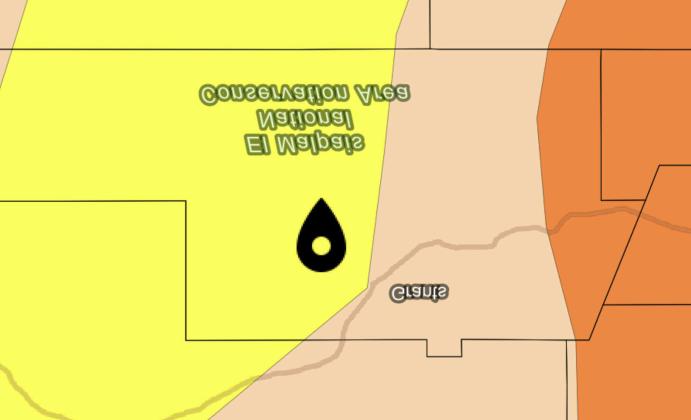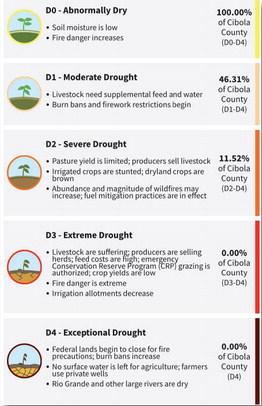Drought conditions in Cibola continue to improve through August thanks to significant rainfall across the county.
August saw an increase in rainfall, with 1.01 inches more than average. August 2022 was the 17th wettest August in the history of drought tracking in the area, going back 128 years. The rainfall was a relief, as dangerous drought affected Cibola earlier in the year.
May and June were months of significant concern for fire personnel across Cibola. At that time, almost all of Cibola County was in “Exceptional Drought,” the most dangerous level of drought recorded by the federal government. This was at the same time the Cerro Bandera Fire was raging in the Zuni Mountains, bringing fear for more large fires in the county. However, significant rainfall in June and July diminished the drought and fire threat. Newley reported data from the National Integrated Drought Information System shows that portions of Cibola County are no longer in drought. Current Drought Rating
In July, 94.77 percent of Cibola was in moderate drought, with a small sliver of Cibola not facing drought, but still dry conditions. As of September 19, only 41.31 percent of Cibola is in moderate drought and 11.52 percent is in severe drought.
Moderate drought, as described by the NIDIS means that livestock will need additional water, and, typically, burn bans are put in place. Severe drought means that the growth of irrigated crops will be stunted, and wildfire danger is significantly increased. Only the eastern portion of Cibola, bordering Bernalillo, Valencia, Socorro and Sandoval Counties is facing severe drought.
All of Cibola is suffering through abnormal dryness, meaning that soil moisture is low.
According to the United States Department of Agriculture, 207 acres of hay are currently in drought across the county. In July, 425 acres of hay were in drought, Cibola has seen a massive improvement in drought conditions.
Haylage has seen a 50 percent decrease in drought conditions across Cibola since August, with August’s numbers showing that only 14 acres of haylage are in drought. 4,761 cattle, and 1,401 sheep are currently in drought. This is down from 9,741 and 2,868 respectively.
12,602 residents of Cibola are currently affected by drought. This is a 51.1 percent decrease from August. According to the National Oceanic and Atmospheric Administration, 46.3 percent of Cibola is currently affected by drought, a 48 percent decrease from August.
Despite the massive improvement in drought conditions across Cibola, the county is still designated as “in drought” by the USDA.
“Exceptional Drought” Tracking
Cibola’s rainfall lessened the shock of the “Exceptional Drought” back in May. 2013 was the first time Cibola entered the “exceptional” category, the rating lasted for several months before ending.
While the county remained in drought, it was not given the “exceptional” rating again until 2020. The rating was assigned in December, and persisted through most of 2021. May of 2022 saw the worst “Exceptional Drought” in county history. The United States Drought Monitor tracks the severity and length of drought across the country. The severity of 2022’s “Exceptional Drought” was starkly more severe than either of the previous two times this rating was assigned to Cibola. However, 2022’s situation lasted for a shorter amount of time than either of the previous two instances.
Thanks to an increase in rainfall, Cibola’s drought situation has done almost a full 180 degree turn from just a few months ago.
Drought Data
The National Integrated Drought Information System is a tool used by the National Oceanic and Atmospheric Administration; a department of the United States known by many as the team who tracks Santa Claus during the Christmas holiday. NIDIS has been tracking drought in the Cibola area since 2006, and they use other historic data and environmental sampling to get a drought reading on years prior, all the way up to 1894. Much of the data Cibola Citizen utilizes comes from NIDIS, but also NOAA and the US Department of Agriculture and the National Agricultural Statistics Service. These entities supply data for Cibola’s acreage of hay and number of livestock.


